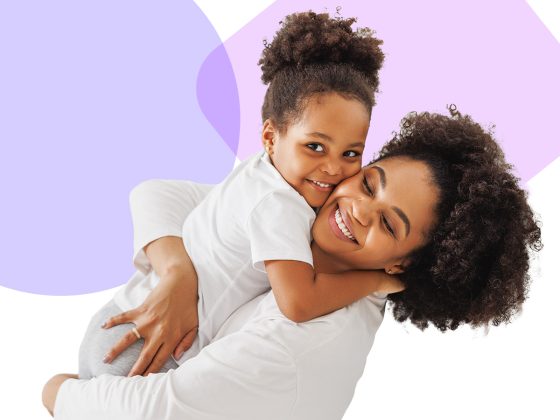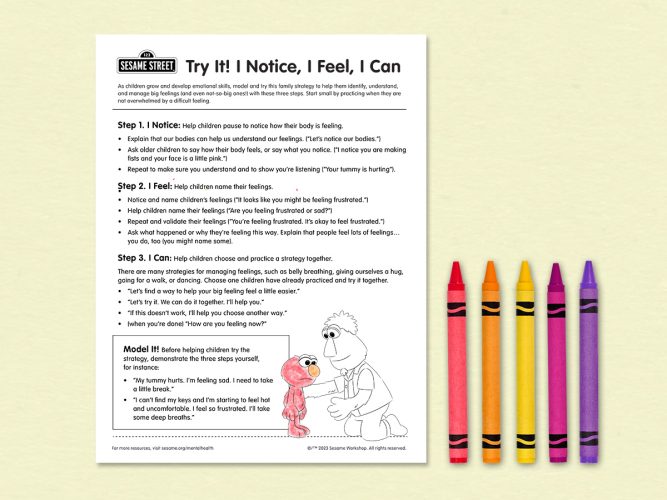
Practice I Notice, I Feel, I Can
Try this three-step plan to help the whole family manage feelings big and small.
For caregiving families like yours, life is often full and fast-paced. Even when—or maybe especially when—there’s so much to do, it can help to take time for self-reflection. Unless we pause every once in a while, it’s not uncommon for little things to build up and big feelings to sneak up on us. This three-step strategy can help you—and your children too—practice emotional awareness and equip your family with ways to cope with feelings big and small.
Each step in the strategy will take practice to become comfortable. It’s okay to break it down and put the pieces together later. Here are ways you might give each step a try. These ideas are great for both kids and adults.
Step 1: I Notice… Pause to notice how your body feels.
Are you shaky or steady? Does your stomach feel tight? Do your shoulders feel heavy? Do you feel jumpy or like you want to move? Sometimes first we need to act like a detective, looking closely to notice the sensations in our bodies. To check in, you might:
- Place one hand on your heart and the other on your belly. Observe if your heartbeat feels fast or slow or if your breathing is deep or shallow and quick.
- Ask yourself questions such as “What do I notice in my throat? In my belly? My head? Do I feel hot or cold?”
- Look at yourself in a mirror. What do you see in your face (a frown or smile)? How are you standing (straight and tall, or maybe with your arms crossed tightly)?
Step 2: I Feel … Name the emotion using a “feelings word.”
Putting a name to an emotion can help us more clearly talk about it and find ways to feel better. But naming emotions can be tricky—there are so many feelings words to choose from! To help your child build their feelings vocabulary, you might:
- Print and display pictures of expressive faces in your home. Hang them near a mirror so you can take turns trying to match the faces.
- Talk about feelings words and make a list of them together. Each time you talk about feelings, see if you can add one or two more words.
- Pause when you are reading or watching TV together. Ask your child what a character might be feeling based on their expression or body language. Share your thoughts, too. It’s okay if you have different ideas.
- Say what you observe in your child: “You are making fists with your hands and your eyebrows are furrowed. To me, it seems like you are feeling mad.” And then ask about it: “Are you feeling mad?” Remind children that they may have different feelings at the same time, and that’s okay.
- Validate your child’s feelings and let them (and yourself) know that feelings come and go, and they won’t always feel this way: “It can be hard to feel ______. We all feel that way sometimes.”
Step 3: I Can … Choose something to help you manage the feeling.
There are lots of ways to regulate our emotions. Consider these ideas.
- Run around or dance. Moving our bodies can help release an emotional response.
- Ask for a hug. Hugging releases stress, and can foster closeness in relationships and help to improve moods.
- Use a glitter jar. In challenging moments, shaking a glitter jar and watching it settle can remind us that things are constantly changing. Big feelings and tough times will come and go.
- Do a big volcano breath. When it feels like there’s a hot, bubbling volcano inside you, this type of breath can help you let it out. Start with your hands together in front of your chest. Breathe in through your nose and raise your arms straight up. The hot lava is rising up and out! Breathe out through your mouth as you move your arms down. The lava flows down to the ground. Repeat as needed.
- Stretch like a cat. Moving can help you focus your child’s energy and attention. Guide them to kneel on their hands and knees. Breathe in as you lift your chin and tilt your head back. Breathe out while you slowly raise your back towards the ceiling and lower your head back to look like a cat. Repeat.
- Try out bumblebee breaths. The vibration of humming can help change how our bodies feel. Breathe in slowly through your nose. Breathe out through your mouth, saying, “bzzz.” Repeat two more times.
- Draw it out. You can draw or doodle how you feel or express your feelings through color, tearing, folding, or stamping.
- Talk it out. Find someone who is safe to talk to. Adults can listen carefully so children can share their feelings, words, sounds, and movements.
After you’re comfortable using a few ideas from each step separately, try using them together. I notice, I feel, I can… is a plan that can help your family work through any emotion that might come up. Remember to be gentle with yourself as you learn and grow in emotional awareness.


